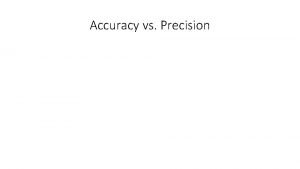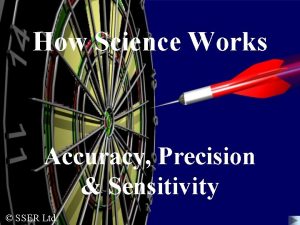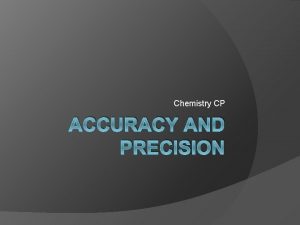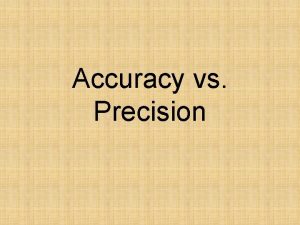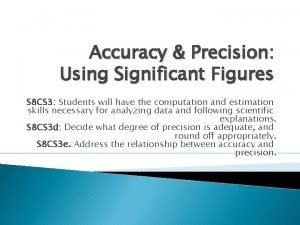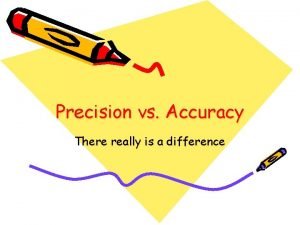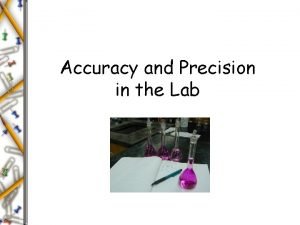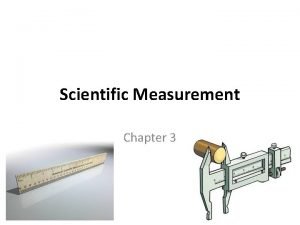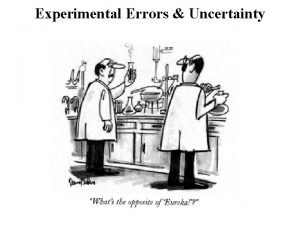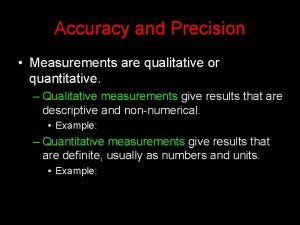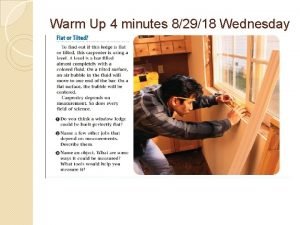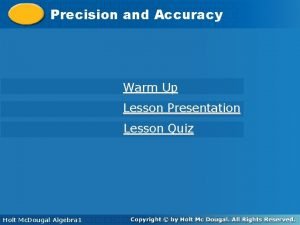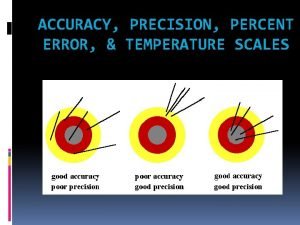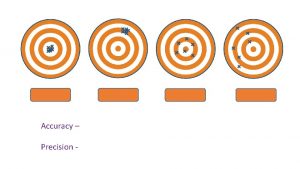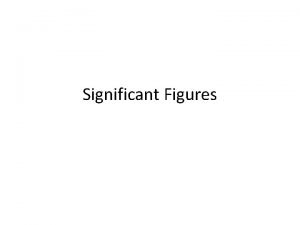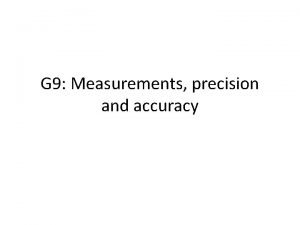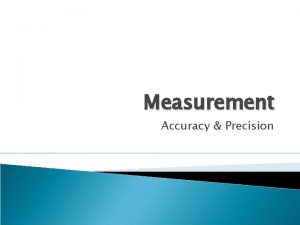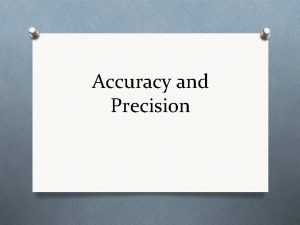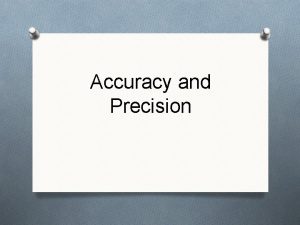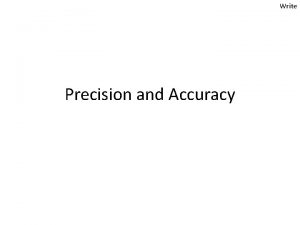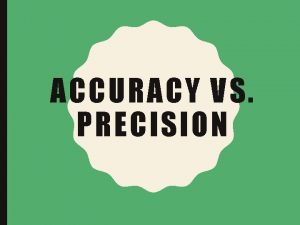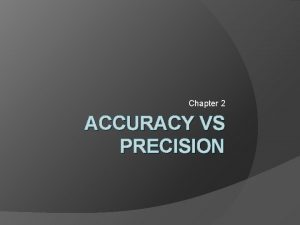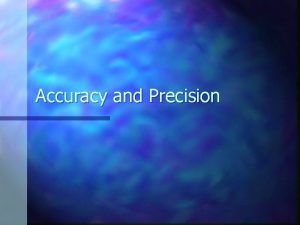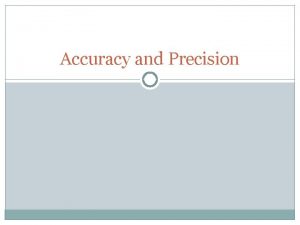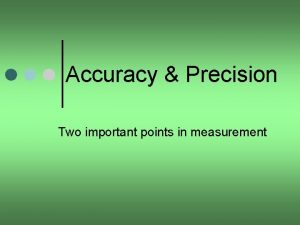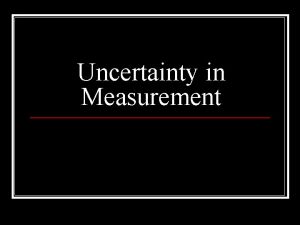Measurement In Science Certainty in Measurement Accuracy Precision





















- Slides: 21

Measurement In Science: Certainty in Measurement: Accuracy, Precision and Significant Figures Chapter menu Resources Copyright © by Holt, Rinehart and Winston. All rights reserved.

Certainty in measurement When measuring quantitative properties of matter you must use a measuring instrument. Measuring instruments are generally graduated- made with marks to show levels of amounts Chapter menu Resources Copyright © by Holt, Rinehart and Winston. All right reserved.

Certainty in measurement Some measuring instruments are more exact than others. This means that every instrument has a certain level of uncertainty- inexactness It is important to be clear about how exact and reliable a measurement is, so that you can decide whether it is trustworthy or not Chapter menu Resources Copyright © by Holt, Rinehart and Winston. All rights reserved.

ACCURACY vs. PRECISION • Accuracy indicates how close a measurement is to the real amount. • Precision indicates how close together or how repeatable the results are. • A precise measuring instrument will give very nearly the same result each time it is used. ( Of course the repeated measurement, may or may not be accurate!)

QUESTION 1: HORSESHOES & HAND GRENADES Watch 3 balls drop and say good or bad for precision and accuracy Target PRECISION ? GOOD! (HIGH) REASON: All 3 of the results are close to each other ACCURACY? • POOR! (LOW) • REASON: All 3 results are WAY off the “actual” targeted value

HORSESHOES & HAND GRENADES QUESTION 2: Watch 3 balls drop and say good or bad for precision and accuracy PRECISION ? POOR! (LOW) REASON: All 3 results are nowhere close to one another ACCURACY? • POOR! (LOW) • REASON: All 3 results come nowhere near the “actual” targeted amount

HORSESHOES & HAND GRENADES QUESTION 3: Watch 3 balls drop and say good or bad for precision and accuracy PRECISION ? GREAT! (High) REASON: All 3 results are right next to each other ( little difference) ACCURACY? • GREAT! (High) • REASON: All 3 results are RIGHT ON the targeted “actual” amount

HORSESHOES & HAND GRENADES QUESTION 4: Watch 3 balls drop and say good or bad for precision and accuracy PRECISION ? PRETTY GOOD! (High) REASON: All 3 are FAIRLY CLOSE to each other (not much difference) ACCURACY? • PRETTY GOOD! (High) • REASON: All 3 are FAIRLY CLOSE to the targeted “actual” amount. (not much difference)

EXAMPLE : ACCURACY Accurate 100 g 100. 00 g Innacurate 100 g 98. 89 g • Example: We'd expect a balance to read 100 grams if we placed a standard 100 g weight on the balance. If it does not, then the balance is inaccurate. (It does not come close to the “actual mass”)

EXAMPLE : PRECISION More Precise Trial # 1 2 3 4 Average Range Std. Dev. Mass (g) 100. 00 100. 01 99. 99 100. 00 ± 0. 01 0. 05 Less Precise Trial # Mass (g) 1 100. 10 2 100. 00 3 99. 88 4 100. 02 Average 100. 00 Range ± 0. 11 Std. Dev. 0. 09 • Example: Notice that the 4 measurements on the right are not as close to each other as the 4 readings on the right. They have less Precision

Reporting Measurements • Report what is known with certainty • Add ONE digit of uncertainty (estimation) Davis, Metcalfe, Williams, Castka, Modern Chemistry, 1999, page 46

Measuring a Pin Zumdahl, De. Coste, World of Chemistry 2002, page 122

Practice Measuring Timberlake, Chemistry 7 th Edition, page 7 0 cm 1 2 3 4 5 4. 54 cm 0 cm 1 2 3 4 5 3. 0 cm 4. 5 cm

Implied Range of Uncertainty 3 4 5 6 Implied range of uncertainty in a measurement reported as 5 cm. 3 4 5 6 Implied range of uncertainty in a measurement reported as 5. 00 cm. Dorin, Demmin, Gabel, Chemistry The Study of Matter 3 rd Edition, page 32

20 ? 15 ? 1 m. L 1. 50 15. 0 xm. L 10

How to Read a Thermometer (Celcius) 4. 0 o. C 10 10 100 5 5 50 0 8. 3 o. C 64 o. C 5 0 3. 5 o. C

Record the Temperature A (Celcius) 60 o. C 6 o C 50 o. C 5 o C 25 o. C 100 o. C 40 o. C 4 o C 20 o. C 80 o. C 3 o C 15 o. C 60 o. C 20 o. C 2 o C 10 o. C 40 o. C 1 o C 5 o C 20 o. C 0 o C 0 o C 30. 0 o. C B 3. 00 o. C C 19. 0 o. C D 48 o. C E 60. o. C

Accuracy vs. Precision • Accuracy - how close a measurement is to the accepted value • Precision - how close a series of measurements are to each other ACCURATE = Correct PRECISE = Consistent Courtesy Christy Johannesson www. nisd. net/communicationsarts/pages/chem

Accuracy vs. Precision Good accuracy Good precision Poor accuracy Good precision Systematic errors: reduce accuracy (instrument) Poor accuracy Poor precision Random errors: reduce precision (person)

Precision Accuracy v reproducibility v correctness v check by repeating measurements v check by using a different method v poor precision results from poor technique v poor accuracy results from procedural or equipment flaws.

Types of errors Systematic • Instrument not ‘zeroed’ properly • Reagents made at wrong concentration Random • Temperature in room varies ‘wildly’ • Person running test is not properly trained
 Accuracy vs precision
Accuracy vs precision Sensitivity accuracy precision
Sensitivity accuracy precision Chemistry definition of accuracy
Chemistry definition of accuracy Accuracy v precision
Accuracy v precision Accuracy and precision significant figures
Accuracy and precision significant figures Uncertainty in multiplication
Uncertainty in multiplication Precision vs accuracy chemistry
Precision vs accuracy chemistry Lab measurement accuracy
Lab measurement accuracy Quick lab accuracy and precision answers
Quick lab accuracy and precision answers Uncertainty of a protractor
Uncertainty of a protractor Is accuracy qualitative
Is accuracy qualitative Brainpop precision and accuracy quiz answers
Brainpop precision and accuracy quiz answers Pmi quality management
Pmi quality management Precision definition
Precision definition Low accuracy low precision
Low accuracy low precision Example of active and passive instruments
Example of active and passive instruments Precision and accuracy
Precision and accuracy Convert celsius to farenheit
Convert celsius to farenheit K h da b d c m
K h da b d c m Accuracy and precision
Accuracy and precision Accuracy and precision
Accuracy and precision Brainpop mindfulness quiz answers
Brainpop mindfulness quiz answers
